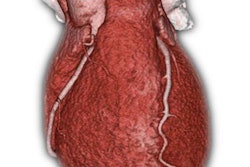Left-ventricular (LV) myocardial fat has been described as a sign of chronic myocardial infarction (MI) and is frequently seen on noncontrast chest CT, Dr. Anna Bader, from Albert Einstein College of Medicine and Jacobi Medical Center in New York City, told AuntMinnie.com. Yet its clinical implications are poorly understood.
The study of 690 patients without MI and 265 patients with prior MI was designed to determine the relationship between myocardial fat and mortality.
"We postulated that LV fat in patients without prior MI indicates silent MI and portends higher mortality, approaching that of patients with a history of MI," Bader said.
But in patients with no MI, myocardial fat was associated with a 25% reduction in hazard of death. In the group with MI, myocardial fat was associated with a 31% adjusted reduction in hazard of death.
"Unexpectedly, patients with myocardial fat have improved survival, regardless of MI status, suggesting that myocardial fat is a beneficial biomarker," Bader said. "Myocardial fat on noncontrast chest CT, a widely used and readily available modality, may improve stratification beyond traditional risk factors."



















